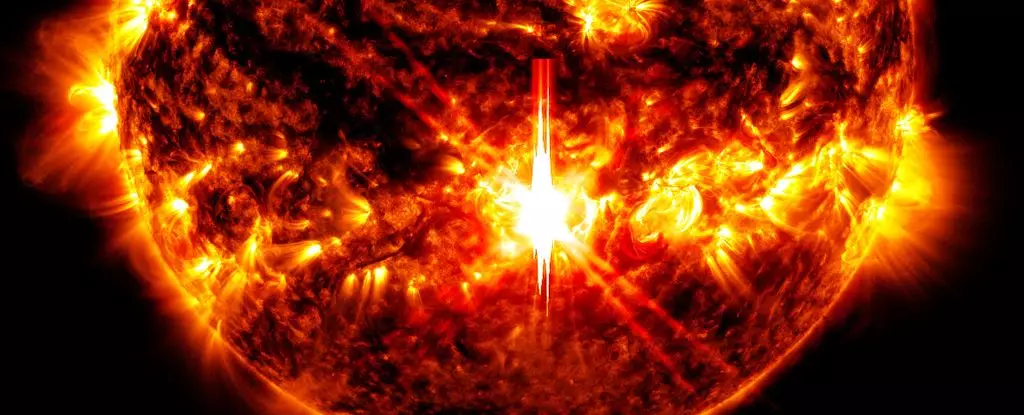On October 3, 2024, the astronomical community was abuzz with excitement as the Sun unleashed one of the most powerful solar flares recorded in recent years. This flare, designated as X9.0, marked the first time since September 2017 that an event of this magnitude had occurred. The flare erupted from the heart of the solar disk and was accompanied by a halo coronal mass ejection (CME), sending a stream of charged particles directly towards Earth. The event exemplifies the peaks of solar activity that typically occur during the Sun’s 11-year cycle, a phenomenon that has implications far beyond mere scientific interest.
While flares like this have been a common occurrence since early 2022, the X9.0 flare stands out as an anomaly even amidst a backdrop of increased solar activity. This flare is particularly noteworthy, as it is not just the second X-class flare of October 2024 but also ranks among the top 20 most potent flares ever recorded. Back-to-back occurrences of significant solar flares can suggest a deeply complex interaction within specific sunspot regions, raising questions about the underlying mechanisms driving these events.
The flare originated from sunspot region AR 3842, which exhibits a convoluted magnetic configuration categorized as Beta-Gamma-Delta. This classification is key to understanding why this sunspot has been producing such intense activity. Sunspots are essentially cooler regions of the Sun’s surface caused by concentrated magnetic fields, leading to a turbulent interplay of magnetic forces. In particular, Beta-Gamma-Delta sunspots foster conditions that promote explosive magnetic reconnection—a process crucial for the occurrence of solar flares.
In fundamental terms, opposing polarities within these sunspots can become tangled, break, and reconnect, releasing massive amounts of energy in the form of solar flares. The Beta-Gamma configuration suggests unstable conditions, while the Delta aspect signifies a higher density of opposing magnetic fields. This intricate interplay of magnetics results in not just one but multiple powerful flares, as seen earlier in the month when an X7.1 flare was recorded.
While the surface of Earth remains relatively safe from the lethal radiation emissions during such solar flares, the high-frequency bursts generated can disrupt communication systems. The more significant concern, however, revolves around the accompanying CMEs. These massive expulsions of solar particles can create electromagnetic disturbances in Earth’s magnetosphere, sometimes leading to geomagnetic storms with cascading effects.
As solar particles interact with Earth’s magnetic field, they can generate electrical currents high up in the atmosphere. This, in turn, can cause fluctuations in power grids, necessitating voltage corrections. Furthermore, satellites are susceptible to increased drag, prompting the need for course adjustments to maintain their orbits. Both satellite communication and GPS services can experience disruption, illustrating the interconnected nature of solar activity and modern technology.
Despite the potential for disruptions, the dazzling natural phenomenon of auroras serves as a silver lining. Following significant solar events, conditions can become favorable for displays of auroras, observable at latitudes far lower than usual, potentially down to 50 degrees latitude. These lights result from frozen gases in Earth’s atmosphere reacting to charged solar particles, creating stunning visual spectacles.
With the X9.0 flare and its associated halo CME poised to affect Earth, astronomers have issued aurora alerts. Especially since the two CMEs from earlier flares were not close enough to create a cumulative impact, it remains likely that those on the northern expanses of countries will enjoy one of nature’s most breathtaking shows. The NOAA has forecasted several days of enhanced aurora conditions, especially throughout the weekend, prompting skywatchers to seize the opportunity.
The anticipation of upcoming auroral activity offers a reminder of how profoundly the space environment influences life on Earth. As flares pulse from the Sun, they serve as more than just a celestial curiosity; they are reminders of our planet’s vulnerability to cosmic events. Astronomers rely on a combination of real-time space weather monitoring and predictive models to safeguard against potential disruptions while allowing a fascinated public to delight in the effects of our dynamic solar system.
October 2024 marks a significant moment in solar activity, one that beckons both excitement and caution. Scientists, communicators, and natural enthusiasts alike stand ready to observe and analyze the consequences of these powerful solar phenomena, ensuring that our understanding of their impact continues to evolve.

